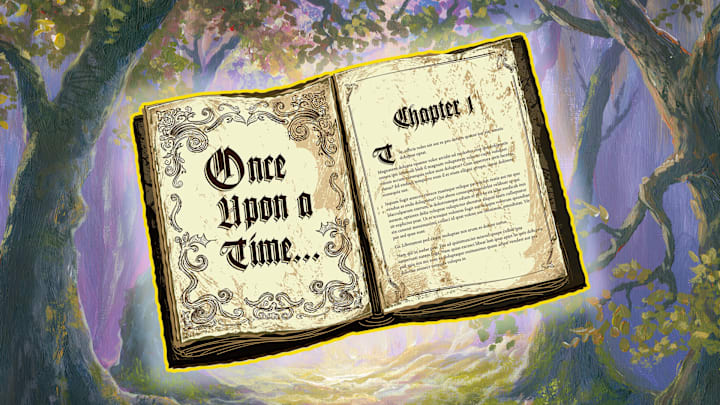There are some tropes that crop up time and time again in fairy tales, from princes and princesses sharing true love’s kiss to evil witches casting magical curses. But the most common shared feature of fairy tales comes at the very beginning.
The words once upon a time form a staple opening phrase that even transcends the English language. Sayings are found in languages around the world: Finnish fairy tales begin with olipa kerran (literally “once there was”), while in Afrikaans the expression is eendag lang, lang gelede (“one day long, long ago”). But why do fairy tales so often begin with once upon a time?
A Tale as Old as Time
The phrase once upon a time didn’t just spring into storybooks—or onto the lips of storytellers—fully formed. A similar expression appears in The Liflade ant te Passiun of Seinte Juliene (The Life and the Passion of Saint Juliana), which has been dated to around 1225. Although preceded by two short introductory paragraphs, the story really kicks off with Wes i thon time, as the redunge telleth (“In that time, as the legend tells”).
The phrase becomes a little more familiar during the 14th century. Onys y wiste oppon a day pops up in Sir Ferumbras, a poem set during Charlemagne’s rule of France and published around 1380; soon afterward, ones on a tyme appears in “The Knight’s Tale” from Geoffrey Chaucer’s The Canterbury Tales.
The words increasingly took their now-standard place at the beginning of stories during the 1500s. Abraham Fraunce’s The Countess of Pembroke’s Ivychurch (1591), for instance, begins with “Once on a time when Nymphs and Pastors chanc’d to be sporting.” By the end of the century, the saying was popular enough to be satirized, with George Peele’s 1595 satiric play The Old Wives’ Tale including the lines, “Once vppon a time there was a King or a Lord, or a Duke that had a faire daughter, the fairest that euer was; as white as snowe, and as redd as bloud.”
Beginning fairy tales with once upon a time was then further solidified thanks to the first English translations of famous fairy tales from Continental Europe. Robert Samber’s 1729 translation of Charles Perrault’s 1695 fairy tale collection renders the French il était une fois (“there was one time”) as “once upon a time.” The same goes for Edgar Taylor’s 1823 translation of es war einmal (“it was once”) from the fairy tales of the German Brothers Grimm. Mary Howitt also chose once upon a time in 1846 when translating Hans Christian Anderson’s Danish fairy tales, which begin der var engang (“there was once”).
There are also a few languages that start stories with something completely different to once upon a time, though. Polish fairy tales typically begin with beyond seven mountains, beyond seven forests (za siódmą górą za siódmym lasem), while Korean folk tales start with when tigers used to smoke (호랑이 담배 피우던 시절, or holangi dambae piudeon sijeol).
Once Upon a Dream
That virtually all languages have a standard starting phrase for fairy tales that removes them from the here and now isn’t mere coincidence—it actually serves a useful purpose. Writer Maria Konnikova points out that this far-flung setting and time period creates a “distance and vagueness,” that provides “an invitation for fantasy and imagination to take the stuff of real life and do with it what they will—and perhaps, to translate the newfound truths back from story to actuality.”
Author Anthony Madrid ascribes a rather more practical reason to folktales not being set in the present: “You’d be opening yourself up for interruptions.” A contemporary setting could lead to questions about who the characters in the story really are, but once upon a time stops those queries in their tracks.
That isn’t the only reason Madrid thinks the phrase caught on, though. Starting fairy tales with a formulaic set of words lets people immediately know what kind of story it’s going to be. Madrid likens this to the information imparted in the first few seconds of watching a cartoon: “The fact of the thing being a cartoon means that almost all the dreariness of adult affairs, and the curdlingness of adult ambiguity, will be excluded. Instead, the presentation will be geared toward enjoyment.” The phrase once upon a time serves this same scene-setting purpose, letting readers and listeners know right away that the story will have a fantasy flourish and (likely) a happily ever after ending.
Read More About Fairy Tales:
